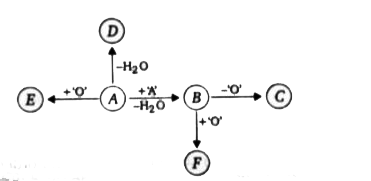Species having X-O-H linkage (X=non-metal with positive oxidation state) are called oxy acids and parent acid of a non-metal may exist in two form (a)-ic form of parent oxy acid (b)-us form parent oxy acid.
Q. Which of the following parent oxy acid does not have its pyro-oxy acid?
The correct Answer is:B
To solve the question regarding which parent oxy acid does not have its pyro-oxy acid, we will analyze each option step by step.
Step 1: Understand Oxy Acids and Pyro-Oxy Acids
- Oxy acids are acids that contain oxygen, hydrogen, and another element (a non-metal) that is typically in a positive oxidation state. They have the general structure X-O-H.
- Pyro-oxy acids are formed when two units of a parent oxy acid lose a water molecule. This results in a new compound that has the structure X-O-X (where X is the non-metal).
Step 2: Analyze Each Option
1. H2SO3 (Sulfurous Acid):
- When two moles of H2SO3 lose water, they form H2O5 (Pyrosulfurous Acid). This means H2SO3 has a pyro-oxy acid.
2. HNO3 (Nitric Acid):
- When two moles of HNO3 lose water, they form N2O5 (Dinitrogen Pentoxide). However, N2O5 does not have any hydrogen atoms bonded to oxygen, meaning it cannot release H+ ions, and thus it does not function as an acid. Therefore, HNO3 does not have a pyro-oxy acid.
3. H3PO3 (Phosphorous Acid):
- When two moles of H3PO3 lose water, they form H4P2O5 (Pyrophosphorous Acid). This means H3PO3 has a pyro-oxy acid.
4. H4SiO4 (Silicic Acid):
- When two moles of H4SiO4 lose water, they form H6Si2O7 (Pyrosilicic Acid). This means H4SiO4 has a pyro-oxy acid.
Step 3: Conclusion
After analyzing all the options, we can conclude that the only parent oxy acid that does not have its pyro-oxy acid is HNO3 (Nitric Acid).
Final Answer:
HNO3 (Nitric Acid) does not have its pyro-oxy acid.
- Oxy acids are acids that contain oxygen, hydrogen, and another element (a non-metal) that is typically in a positive oxidation state. They have the general structure X-O-H.
- Pyro-oxy acids are formed when two units of a parent oxy acid lose a water molecule. This results in a new compound that has the structure X-O-X (where X is the non-metal).
1. H2SO3 (Sulfurous Acid):
- When two moles of H2SO3 lose water, they form H2O5 (Pyrosulfurous Acid). This means H2SO3 has a pyro-oxy acid.
- When two moles of HNO3 lose water, they form N2O5 (Dinitrogen Pentoxide). However, N2O5 does not have any hydrogen atoms bonded to oxygen, meaning it cannot release H+ ions, and thus it does not function as an acid. Therefore, HNO3 does not have a pyro-oxy acid.
- When two moles of H3PO3 lose water, they form H4P2O5 (Pyrophosphorous Acid). This means H3PO3 has a pyro-oxy acid.
- When two moles of H4SiO4 lose water, they form H6Si2O7 (Pyrosilicic Acid). This means H4SiO4 has a pyro-oxy acid.
After analyzing all the options, we can conclude that the only parent oxy acid that does not have its pyro-oxy acid is HNO3 (Nitric Acid).
HNO3 (Nitric Acid) does not have its pyro-oxy acid.
Topper's Solved these Questions
- p-BLOCK ELEMENTSBOOK - VK JAISWAL ENGLISHCHAPTER - p-BLOCK ELEMENTSEXERCISE - ONE OR MORE ANSWERS IS/ARE CORRECT
95 Videos
- p-BLOCK ELEMENTSBOOK - VK JAISWAL ENGLISHCHAPTER - p-BLOCK ELEMENTSEXERCISE - MATCH THE COLUMN
24 Videos
- p-BLOCK ELEMENTSBOOK - VK JAISWAL ENGLISHCHAPTER - p-BLOCK ELEMENTSEXERCISE - LEVEL 2
97 Videos
- METALLURGYBOOK - VK JAISWAL ENGLISHCHAPTER - METALLURGYEXERCISE - ASSERTION-REASON TYPE QUESTIONS
29 Videos
- PERIODIC PROPERTIESBOOK - VK JAISWAL ENGLISHCHAPTER - PERIODIC PROPERTIESEXERCISE - MATCH THE COLUMN
11 Videos
Similar Questions
Species having X-O-H linkage (X=non-metal with positive oxidation state) are called oxy acids and parent acid of a non-metal may exist in two form (a)-ic form of parent oxy acid (b)-us form parent oxy acid.
Q. X-O-X bond (where X=central atom) is not present in species.
View SolutionSpecies having X-O-H linkage (X=non-metal with positive oxidation state) are called oxy acids and parent acid of a non-metal may exist in two form (a)-ic form of parent oxy acid (b)-us form parent oxy acid.
Q. Number of P-O bond(s) having bond order=2, in P2O4−6 ions is:
View SolutionWhich of the following parent acid(s) does/do not have corresponding hypo-oxyacid?
View SolutionWhich of the following parent acid(s) does/do not have corresponding hypo-oxyacid?
View SolutionEach oxy-acid contains at least one X-OH unit (X is non-metal). The H-atom of X-OH unit is ionisable and the number of -OH groups directly attach to non-metal decides the basicity of oxy-acid.
Q. Which of the following oxy-acid does not have its peroxy form having two central atoms?
View SolutionEach oxy-acid contains at least one X-OH unit (X is non-metal). The H-atom of X-OH unit is ionisable and the number of -OH groups directly attach to non-metal decides the basicity of oxy-acid.
Q. Which of the following oxy-acid does not have its peroxy form having two central atoms?
View SolutionMetaphosphoric acid exists in polymeric form and may have :
View SolutionName a non-metallic element which forms an acidic and a neutral oxide.
View SolutionThe element with atomic number 14 is hard and forms acidic oxide and a covalent halide. To which of the following categories does the element belong ?
View SolutionConsider the following sequence of reactions, if A is sulphuric acid, then give the answer of following questions

Q. Which of the following oxy acid does not have peroxy (-O-O-) linkage?
View Solution
